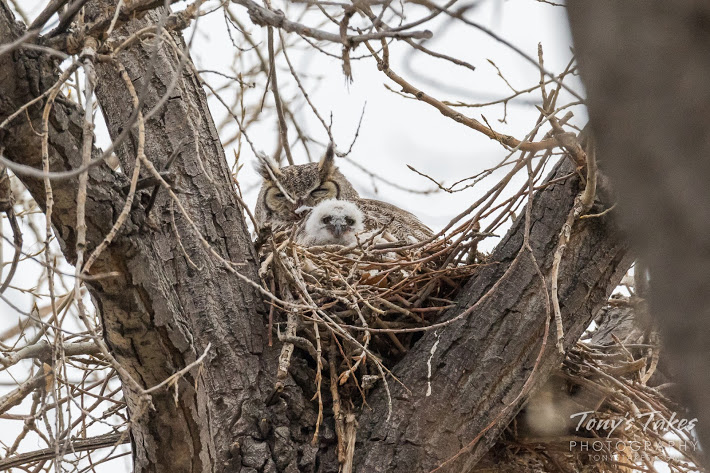Unlike smaller owls species which are known to live in abandoned nests of other birds such as woodpeckers or other natural cavities, great horned owls just don’t nest like that. The great horned owl is nearly the size of an eagle or a hawk thus they occupy old stick nests which are built by other raptors such as hawks or eagles. Owls aren’t generally thought to be hard workers. They just don’t build nests like some house sparrows do. Males do not incubate the eggs, only females do all the hard world. Nonetheless, the male owl will fly out to bring some food for chicks as well as for the female. Perhaps you might like to learn more about great horned owl nest.
Great Horned Owl Nest Facts – How Do Great Horned Owls Build Nest?

The nest-building activity of a great horned owl is strongly linked to the availability of a prey; the greater is the prey the earlier they will breed. Furthermore, the female likely produces large clutches of eggs and the chicks fledge out on time when the food supply is abundant. But if the food is scarce the owl will nest later in the season. More so, if the prey is below the minimum requirements the owl will probably choose not to nest at all.
The nest-building activity of a great horned owl is strongly linked to the availability of a prey; the greater is the prey the earlier they will breed.
Compared to other North American birds, great horned owls nest earlier in the season. The breeding season is most likely to occur in winter because the birds are largely nocturnal they fancy choosing lengthy nightfall to nest. The great horned owl nests from October to December but they begin choosing their mates in December and January.
Early research indicated that great horned owls were monogamous that is, they pair for life. However, over time scientists discovered that adult male owls will mate with a couple of females at the same time. This was first observed in the great horned owl population inhabiting Nevada.
READ: [Great Horned Owl Lifespan]
How Do Males Attract the Females in Breeding Season?
Not only do they rely on hearing sense for hunting their prey, great horned owls will repeatedly hoot to search for their mating partners. However, when they look for partners at dusk they’ll rely on their keen eyesight.
Many a times the adult male puffs up white throat to signal the female that he’s interested but they also fly awkwardly as they approach the female. If a female shows her positive intent then the male will step towards her and rubs the bill against her’s. The female will then produce low-pitched hooting call to communicate to her partner that she’s ready to mate.
But, in order to convince the female there’s another way too. That is, the male flies out and brings a fresh prey to the female while both shares the meal. During all this time, the male will continue to hoot for as long as 40 days while the female hoots for up to 10 days.
Although not exclusively, great horned owls become monogamous for most part of the year and they are on their own once the juveniles attain maturity. Both male and female do all the courtship to make sure they bond for life—something which isn’t uncommon in great horned owls.

How Do Great Horned Owls Build or Choose their Nest?
Adult male will choose the nesting site. The ideal nesting site would be on high branches preferably the one with an open access. The male will fly to the desired nesting site and possibly stomp the female to tell her about their new home. But owls are not known to build nests; they just take over the abandoned nests. Great horned owls will often occupy the bald eagle’s nest by harassing and driving them away.
As is typical of large raptors, great horned owls nest in open places but their nests are found in the widest of places where a very few North American birds will nest. They can utilize tree hollows or branches of dead trees. The southern population typically nests in abandoned trees.
READ: [Baby Great Horned Owl]
The great horned owl’s nesting sites includes small caves, canyons, cliff edges, hilly areas, and depressions. If however they couldn’t find any of these desired nesting sites the owls will nest on man-made structures, low bushes, or even non-native trees. The female may even lay eggs on debris it finds as a suitable site.
Great horned owls inhabiting Florida typically nest amidst bushy spots or even tall grasses. More so, a few researchers have witnessed female hoot owl laying eggs in a coyote’s dens although these mammals are the predators of owl’s eggs.
The great horned owl’s nest mostly sits 4.5 to 22 meters (15 to 72 feet) off the ground. While they do not usually build nests the female owl will occasionally line the nest with some sticks or feathers. The southwest population of owls is known to occupy nests of Harrier’s hawks or golden eagles. They can also use heron’s or Canada goose’s nest but only sometimes. Since great horned owls are large raptors they prefer to live in nests built of sticks rather than leaves. However, they have been observed sitting on a squirrel’s nest too.
Great Horned Owl Nest – Video
References
Baumgartner, F. M. (1938). Courtship and nesting of the great horned owls. The Wilson Bulletin, 274-285.
Voous, K.H. 1988. Owls of the Northern Hemisphere. The MIT Press, 0262220350.
Houston, C. Stuart, Dwight G. Smith and Christoph Rohner. 1998. Great Horned Owl (Bubo virginianus), The Birds of North America Online (A. Poole, Ed.). Ithaca: Cornell Lab of Ornithology; Retrieved from the Birds of North America Online.
König, Claus; Weick, Friedhelm (2008). Owls of the World (2nd ed.). London: Christopher Helm. ISBN 9781408108840.












